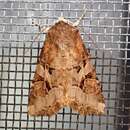Conservation Status
provided by University of Alberta Museums
A widespread but uncommon moth; no obvious concerns.
- license
- cc-by-nc
- copyright
- University of Alberta Museums
Cyclicity
provided by University of Alberta Museums
Adults have been collected in Alberta from late May through early July.
- license
- cc-by-nc
- copyright
- University of Alberta Museums
Distribution
provided by University of Alberta Museums
Across Canada in the southern boreal forest and transition zones, from Nova Scotia west to Vancouver Island, and south to California and Colorado in the west, and New York and Michigan in the east. In Alberta it has been collected north to Pocahontas and Edmonton, and south to Tolman Bridge and Calgary. A specimen reported from extreme northeastern Alberta (Macaulay and Pohl, 2002) has been re-identified as T. legitima.
- license
- cc-by-nc
- copyright
- University of Alberta Museums
General Description
provided by University of Alberta Museums
A medium-size (approx. 3.4-3.8 cm. wingspan) patterned red-brown, blue grey and black moth. The basal two-thirds of the wing are red-brown, crossed by narrow pale grey antemedian and post median lines. The area between the two lines contains the large, round blue-grey orbicular spot (as large as the reniform) and red-brown reniform spots. The reniform is joined to the pale blue-grey postmedian band by a line of grey scales along the lower branch of the cubital vein. The space immediately below the reniform is partially filled with black scales, and there is a rather prominent black claviform spot. The postmedian area is pale blue-grey, bordered distally by a barrow red-brown terminal area with a shallow w-mark dividing it midway. The hindwings are sooty brown, shading into a broad dark terminal band. Antennae simple and sexes similar. Easily mistaken for the more common, widespread and variable T. dodii. Dodii has a less prominent blue-grey postmedian band, and a smaller orbicular spot (smaller than the reniform.) which is partially filled with brown scales. T. legitima also has a less prominent orbicular spot, lacks the black scaling below the reniform and is more grey than brown in the lower basal area. There are also a number of genitalic characters that can be used to separate the three species.
- license
- cc-by-nc
- copyright
- University of Alberta Museums
Habitat
provided by University of Alberta Museums
Meadows, wooded edges; open woodland and shrubby areas.
- license
- cc-by-nc
- copyright
- University of Alberta Museums
Life Cycle
provided by University of Alberta Museums
Poorly known. Adults are nocturnal and come to light, and there is a single annual brood.
- license
- cc-by-nc
- copyright
- University of Alberta Museums
Trophic Strategy
provided by University of Alberta Museums
The larvae are general feeders and have been reported on a variety of plants in a number of families, including Thimbleberry (Rubus); willow (Salix>), Epilobium, Prunus, Sambucus, Vaccinium myrtilloides, Spiraea latifolia, White birch (Betula papyrifera), dogbane (Apocynum androsaemifolium). (Handfield, 1999; Rockburne and Lafontaine, 1976).
- license
- cc-by-nc
- copyright
- University of Alberta Museums
Trichordestra tacoma
provided by wikipedia EN
Trichordestra tacoma, the Tacoma polia, is a species of cutworm or dart moth in the family Noctuidae. It is found in North America.[1][2][3]
The MONA or Hodges number for Trichordestra tacoma is 10303.[4]
References
- license
- cc-by-sa-3.0
- copyright
- Wikipedia authors and editors
Trichordestra tacoma: Brief Summary
provided by wikipedia EN
Trichordestra tacoma, the Tacoma polia, is a species of cutworm or dart moth in the family Noctuidae. It is found in North America.
The MONA or Hodges number for Trichordestra tacoma is 10303.
- license
- cc-by-sa-3.0
- copyright
- Wikipedia authors and editors

